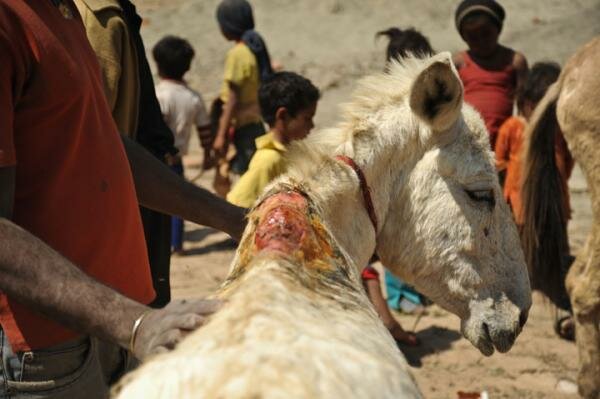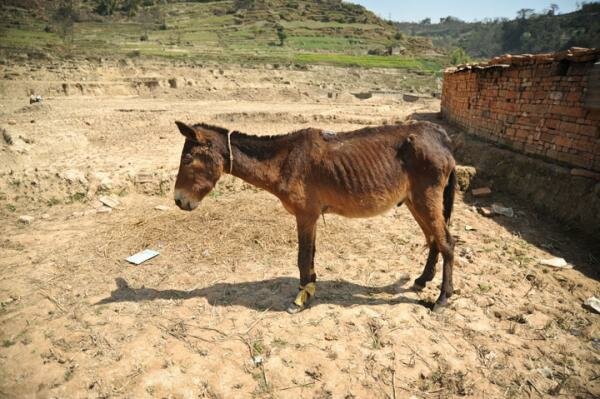Donkeys in Peril

 1 of 23
1 of 23 
In addition to the child labour story that predominates Kathmandu valley’s brick factories, is the untold story of donkeys. These domestic animals are the backbone of brick production, working day and night hauling the heavy loads of materials that eventually become the foundation of the ever-expanding metropolis of Kathmandu.
(Left) Man and animal work side by side in the dry and dusty brick factories. A horse hauls a load of dry bricks from the drying docks as a man wheels out a fresh parcel of wet bricks ready to be stacked in the sun. An estimated 2,000 animals are brought into the valley every year on the back of trucks to work at these brick factories.
Text and photos by Debby Ng
Related Story:

 2 of 23
2 of 23 
Horses, mules, and donkeys move like clockwork, up and down the length of the factory without any prodding or instruction. The animals have been trained over several seasons and the rhythm of the brick factory is well ingrained. The animals even know what time of day to stop and where to go for lunch and water. The handlers move according to this rhythm as well and take cues from the animals on when to stop for lunch and when to fetch water.
Text and photos by Debby Ng

 3 of 23
3 of 23 
Dr. Sudeep is a veterinarian with Animal Nepal. He makes regular visits to 12 brick factories throughout Katmandu’s Lalitpur District to inspect the conditions of the equines, educate animal handlers, and administer drugs to the animals if necessary. He inspects an old working horse as bricks are loaded onto its harness.
Text and photos by Debby Ng

 4 of 23
4 of 23 
Apart from mules, which are a hybrid between a female horse and a male donkey, horses, donkeys and unusual hybrids can also be found working these kilns. A donkey stands firm as bricks are loaded onto its harness, while a mule awaits its turn. Animal Nepal estimates 15 % of working equines in the valley comprise horses, 35% donkeys, and 50% mules.
Text and photos by Debby Ng

 5 of 23
5 of 23 
Entire families migrate from Nepal’s southern low lands every season to work the brick factories. Kadir Ali Khan, together with his wife, ReshuNisha, and six of their children are a Muslim family that has journeyed from Nepalgunj to spend six months working at Harisiddhi brick factory.
Text and photos by Debby Ng

 6 of 23
6 of 23 
The lattices formed by wet bricks laid out to dry in the sun, form a screen behind which small and stunted equines labour ceaselessly. A single brick kiln can be owned by three to four owners who pay their workers 400 Nepali Rupees for every 1,000 bricks processed. One brick factory owner in Lalitpur District has successfully established a “Greenbrick” factory, which does not use child or animal labour, and requires only 50 persons to operate instead of the usual 600 people required to work traditional factories like this one in Harisiddhi.
Text and photos by Debby Ng

 7 of 23
7 of 23 
An old horse that has laboured at the brick factory for several seasons has completely lost vision in one of its eyes. Education of the animal handlers can provide immediate welfare improvements to the animals. Animal Nepal also provides specially designed harnesses that give better support when compared to the ones made by animal handlers from improvised scrap materials.
Text and photos by Debby Ng

 8 of 23
8 of 23 
Inbreeding of the equines can lead to unusual hybrids such as this one, which though small and strong, suffers some physical deformities and will have a short lifespan. Two of Kadir Ali Khan’s children play on a tarpaulin in the background.
Text and photos by Debby Ng
Related Story:

 9 of 23
9 of 23 
Kadir Ali Khan lifts the lip of one of the unusual hybrids that work in the brick factory. This individual suffers from a cleft palate and severe under bite. The animals are not owned by the factory or its workers, they are “on rent” from breeders from Nepalgunj. A fee is paid to lease these animals – horses are the most expensive, which is why they are the least popular. Female donkeys cost around 5,000 NRps, while males fetch between 8-10,000 NRps because they are perceived to be stronger. As such, females receive poorer welfare treatment than the males.
Text and photos by Debby Ng

 10 of 23
10 of 23 
Dr. Sudeep administers a painkiller to one of the working donkeys at the brick factory. The small animals tremble, and their knees and toes buckle under the weight of the load which weighs at least 70 kg. Healthy donkeys can live up to 24 years but those that work at these factories will die between three to 15 years.
Text and photos by Debby Ng

 11 of 23
11 of 23 
An animal handler fills up a trough with dried maize grains in the middle of the day when the sun is at its highest and both animal and man return to the shade for a moment’s rest.
Text and photos by Debby Ng

 12 of 23
12 of 23 
A horse grazes along a strip of grass between walls of wet bricks. In September 2010, Animal Nepal rescued one blind horse, Mukti, with her foal Shakti from Tri Shakti Brick Factory. Veterinarians said Mukti would have died within a week if she were not rescued. Both mare and foal were severely malnourished and have now retired from work at Animal Nepal’s working equine sanctuary in Godavari.
Text and photos by Debby Ng

 13 of 23
13 of 23 
Most equines are imported from India and bought at fairs at Barabanki, Nanpara and Barich. Nepalese owners generally buy discarded equines, including lame, blind, old, pregnant and sick ones. Animal Nepal produced a brochure in Nepali and Hindi to explain the rules for importing equines and fines for bringing in sick or injured animals.
Text and photos by Debby Ng

 14 of 23
14 of 23 
A young foal observes other horses and donkeys work alongside men in the brick kilns. If a mother and foal get the right amount of nourishment and care, the foal can mature into an adult. But it is hard to determine if surviving into adulthood in a brick kiln is a blessing or a curse.
Text and photos by Debby Ng

 15 of 23
15 of 23 
Brick workers prod a pair of mules out of the way at Bol Bum Brick Kiln in Godavari. Animal Nepal is working to engage factory owners to convince them of the need to register equine owners with Animal Nepal. They want to tag equines according to the brick kilns they are working at so as to help ensure proper shelter, nutrition and management is provided.
Text and photos by Debby Ng

 16 of 23
16 of 23 
A horse handler prods a horse back to the loading area as another horse carries a harness load of bricks to the storage area, in Bol Bum Brick Factory in Godavari. Although, factory owners responded positively to Animal Nepal’s suggestions, there appears to be a lack of will as the owners are often unable to meet or talk during follow-up efforts.
Text and photos by Debby Ng

 17 of 23
17 of 23 
A horse handler holds on to his horse as he waits for other horses to receive their load of bricks. During the off-season, Animal Nepal continues to work with animal handlers and donkeys that might remain in Kathmandu Valley. Animal Nepal conducted regular visits to help improve husbandry skills and organized health camps to deworm and vaccinate equines.
Text and photos by Debby Ng

 18 of 23
18 of 23 
Dr. Sudeep tends to a mare that is blind in one eye, at Sri No. 1 Brick Kiln in Bungamati. The old and severely malnourished horse has multiple diseases and is caressed by another horse nearby while awaiting her treatment.
Text and photos by Debby Ng

 19 of 23
19 of 23 
A donkey with a severe sore along its back awaits treatment as a young child looks on, at Sri No. 1 Brick Kiln in Bungamati.
Text and photos by Debby Ng

 20 of 23
20 of 23 
At least two equines were found at Sri No. 1 Brick Kiln in Bungamati, with severe sores along their backs. Dr. Sudeep explained that in hot weather, the skin of these animals becomes more fragile and tears and bruises easily. Despite the apparent discomfort that the animals are enduring, they will continue to work as long as they are capable of walking. Because of this, several health issues are not addressed until it is too late.
Text and photos by Debby Ng

 21 of 23
21 of 23 
A blind and malnourished mare stands alone in the sun after receiving treatment from the Animal Nepal team. Although it may look like its on the brink of deathf, this mare will and continues to work in the brick kiln.
Text and photos by Debby Ng
Related Story:

 22 of 23
22 of 23 
IndraTuladhar is setting an example for other brick kiln owners in the valley. Bungamati Brick Industry is the only one of its kind that not only does not employ animals and children, but his machines that where purchased from China have also allowed him to cut the number of his staff by nearly 90 percent. Increasing the efficiency of his factory also means that he has reduced his environmental impact. Bungamati Brick Industry is the first and only brick factory to be awarded the “Green Brick” Label. Hopefully, more factories will adapt his approach in the near future.
Text and photos by Debby Ng

 23 of 23
23 of 23 
Partnerships are crucial to improving the conditions of both human and animal workers in Kathmandu’s brick kilns. Without the support and understanding of animal handlers such as Kadir Ali Khan, the animals do not stand a chance. Patience and empathy is necessary to forge sustainable, long term and effective relationships between welfare groups and beneficiaries.
Text and photos by Debby Ng























